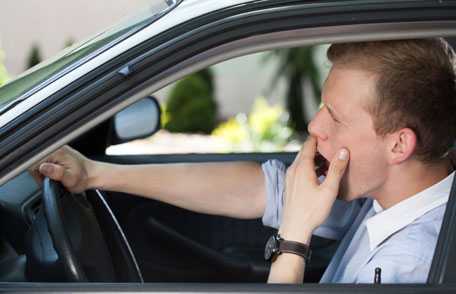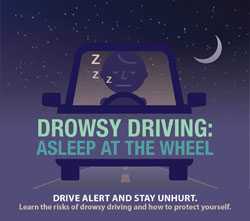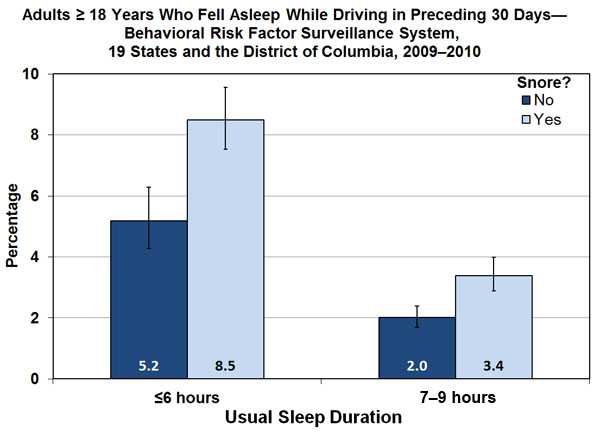Drowsy Driving: Asleep at the Wheel

Drive alert and stay unhurt. Learn the risks of drowsy driving and how to protect yourself.
The Drowsy Driving Problem
Drowsy driving is a major problem in the United States. The risk, danger, and often tragic results of drowsy driving are alarming. Drowsy driving is the dangerous combination of driving and sleepiness or fatigue. This usually happens when a driver has not slept enough, but it can also happen due to untreated sleep disorders, medications, drinking alcohol, or shift work.
No one knows the exact moment when sleep comes over their body. Falling asleep at the wheel is clearly dangerous, but being sleepy affects your ability to drive safely even if you don’t fall asleep. Drowsiness—
- Makes drivers less able to pay attention to the road.1
- Slows reaction time if you have to brake or steer suddenly.1
- Affects a driver’s ability to make good decisions.1

Researchers estimate that more than 70 million Americans suffer from a sleep disorder. (Institute of Medicine, 2005).10
Infographic [152 KB]
Did You Know?
- An estimated 1 in 25 adult drivers (aged 18 years or older) report having fallen asleep while driving in the previous 30 days.2-3
- The National Highway Traffic Safety Administration estimates that drowsy driving was responsible for 72,000 crashes, 44,000 injuries, and 800 deaths in 2013.4 However, these numbers are underestimated and up to 6,000 fatal crashes each year may be caused by drowsy drivers.5-7
Who’s more likely to drive drowsy?
- Drivers who do not get enough sleep.8
- Commercial drivers who operate vehicles such as tow trucks, tractor trailers, and buses.
- Shift workers (work the night shift or long shifts).
- Drivers with untreated sleep disorders such as one where breathing repeatedly stops and starts (sleep apnea).
- Drivers who use medications that make them sleepy.
Learn the warning signs of drowsy driving—
- Yawning or blinking frequently.
- Difficulty remembering the past few miles driven.
- Missing your exit.
- Drifting from your lane.
- Hitting a rumble strip on the side of the road.
If you experience any of these warnings signs, pull over to rest or change drivers. Simply turning up the radio or opening the window are not effective ways to keep you alert. For more warning signs visit American Academy of Sleep Medicine.
How often do Americans fall asleep while driving?
- Among nearly 150,000 adults aged at least 18 years or older in 19 states and the District of Columbia, 4%reported that they had fallen asleep while driving at least once in the previous 30 days.2
- Individuals who snored or usually slept 6 or fewer hours per day were more likely to report falling asleep while driving.2

Wheaton AG, Chapman DP, Presley-Cantrell LR, Croft JB, Roehler DR. Drowsy driving – 19 states and the District of Columbia, 2009-2010. [630 KB] MMWR Morb Mortal Wkly Rep. 2013; 61:1033.
Prevent drowsy driving, before taking the wheel
There are a few things you should do before taking the wheel to prevent driving while drowsy.
- Get enough sleep! Most adults need at least 7 hours of sleep a day, while teens need at least 8 hours.9
- Develop good sleeping habits such as sticking to a sleep schedule.
- If you have a sleep disorder or have symptoms of a sleep disorder such as snoring or feeling sleepy during the day, talk to your physician about treatment options.
- Avoid drinking alcohol or taking medications that make you sleepy. Be sure to check the label on any medications or talk to your pharmacist.
If you notice the warning signs of drowsy driving, pull over to a safe place and take a 15-20 minute nap or change drivers.
References
- Jackson ML, Croft RJ, Kennedy GA, Owens K, Howard ME. Cognitive components of simulated driving performance: sleep loss effects and predictors. Accid Anal Prev.2012;50:438.
- Wheaton AG, Chapman DP, Presley-Cantrell LR, Croft JB, Roehler DR. Drowsy driving – 19 states and the District of Columbia, 2009-2010. [630 KB] MMWR Morb Mortal Wkly Rep. 2013; 61:1033.
- Wheaton AG, Shults RA, Chapman DP, Ford ES, Croft JB. Drowsy driving and risk behaviors—10 states and Puerto Rico, 2011-2012. [817 KB] MMWR Morb Mortal Wkly Rep. 2014; 63:557-562.
- National Highway Traffic Safety Administration. Research on Drowsy Driving. Accessed October 20, 2015.
- Masten SV, Stutts JC, Martell CA. Predicting daytime and nighttime drowsy driving crashes based on crash characteristic models. 50th Annual Proceedings, Association for the Advancement of Automotive Medicine; October 2006; Chicago, IL.
- Klauer SG, Dingus TA, Neale VL, Sudweeks JD, Ramsey DJ. The Impact of Driver Inattention on Near-Crash/Crash Risk: An Analysis Using the 100-Car Naturalistic Study Data, 2006 . Springfield, VA: DOT; year. DOT HS 810 594.
- Tefft BC, AAA Foundation for Traffic Safety. Prevalence of Motor Vehicle Crashes Involving Drowsy Drivers, United States, 2009 – 2013 [457 KB].Washington, DC: AAA Foundation for Traffic Safety; 2014. October 19, 2015.
- Stutts JC, Wilkins JW, Scott Osberg J, Vaughn BV. Driver risk factors for sleep-related crashes. Accid Anal Prev. 2003;35(3):321-31.
- National Institute of Health, National Heart, Lung, and Blood Institute. How Much Sleep is Enough? Accessed October 19, 2015.
- Institute of Medicine. Sleep Disorders and Sleep Deprivation: An Unmet Public Health Problem. Washington, DC: The National Academies Press; 2006.
More Information
- Page last reviewed: November 5, 2015
- Page last updated: November 5, 2015
- Content source:
- National Center for Chronic Disease Prevention and Health Promotion, Division of Population Health
- Page maintained by: Office of the Associate Director for Communication, Digital Media Branch, Division of Public Affairs




 ShareCompartir
ShareCompartir